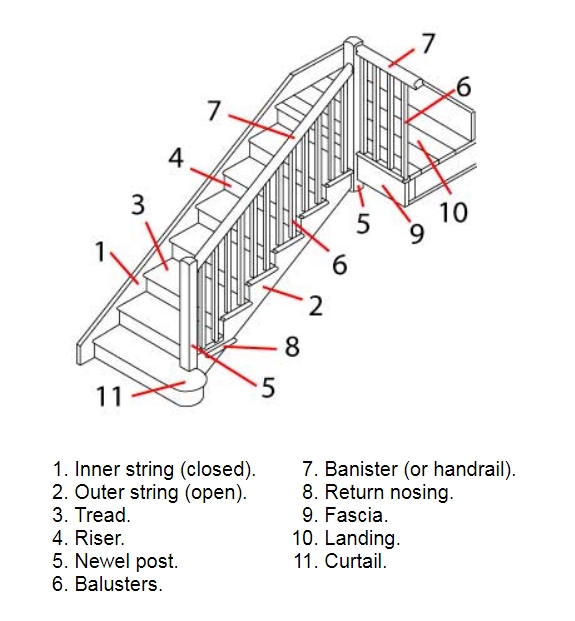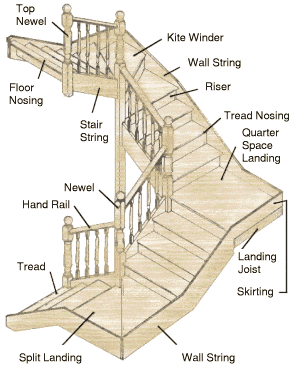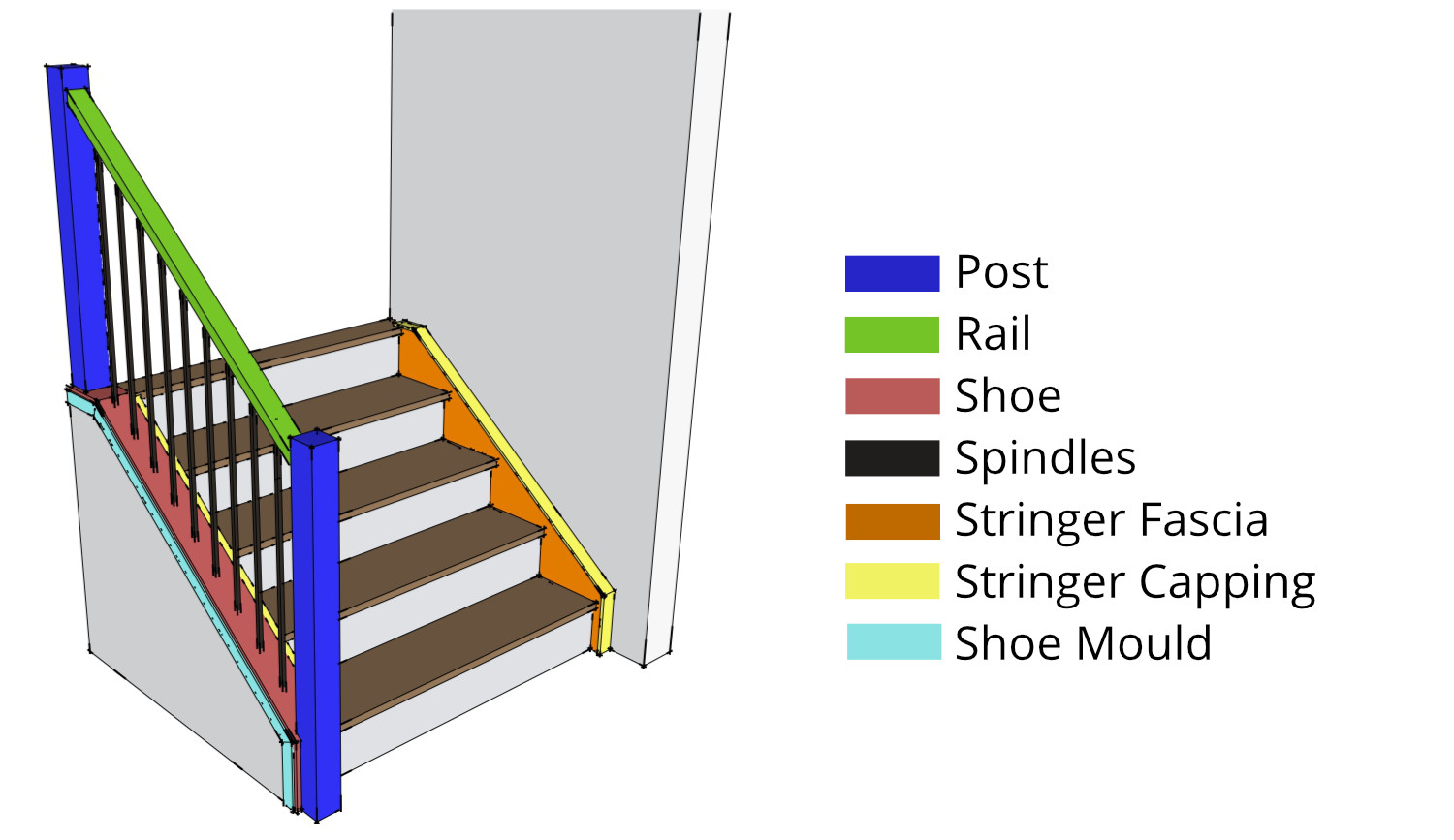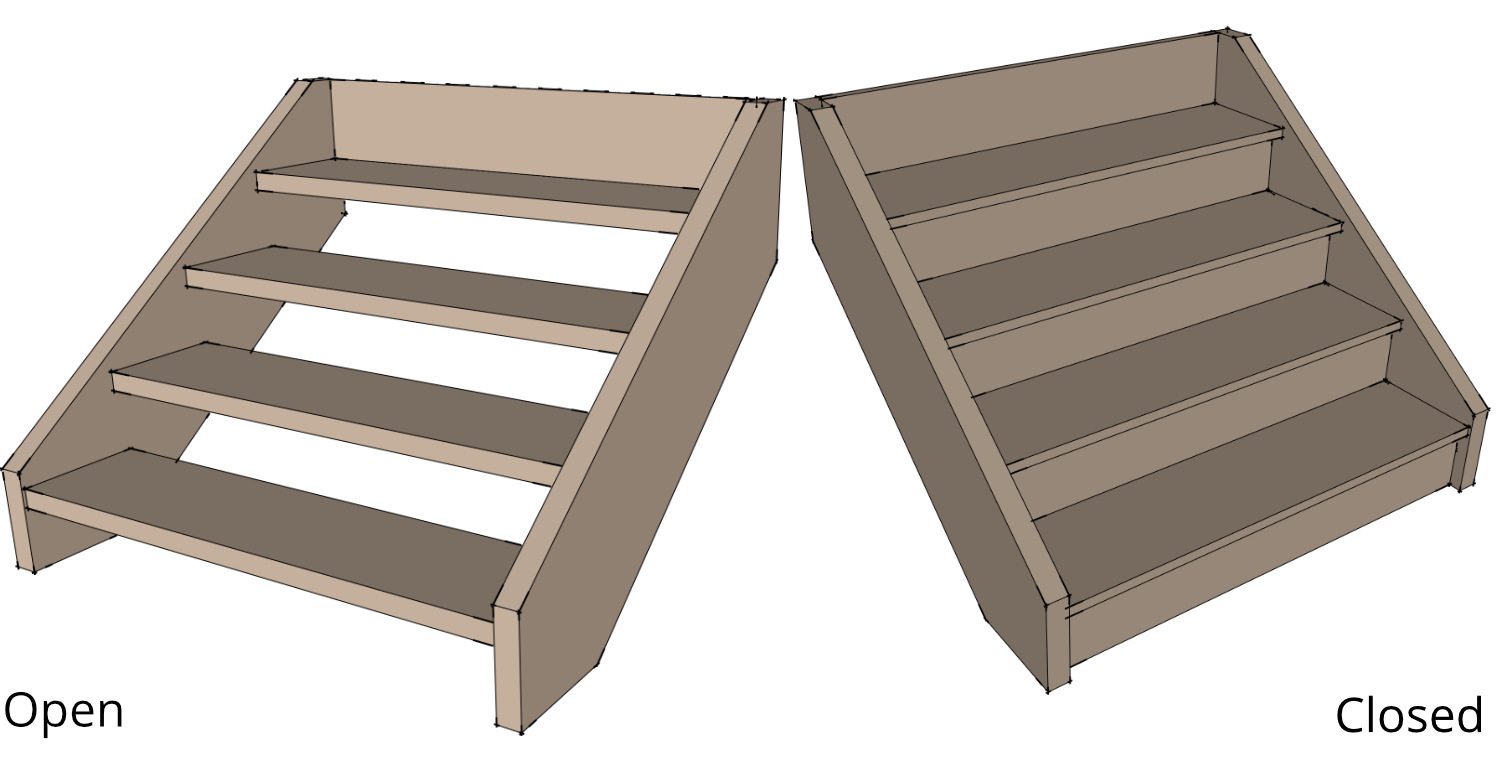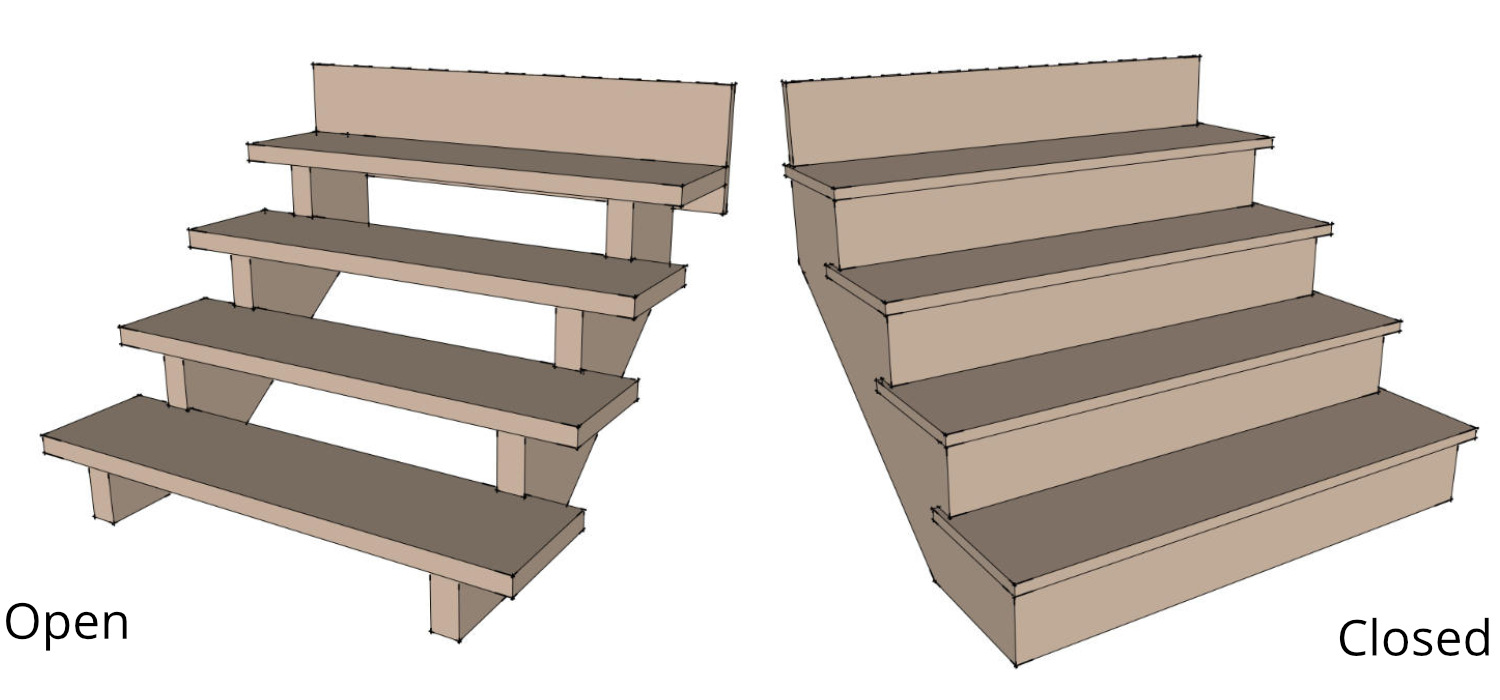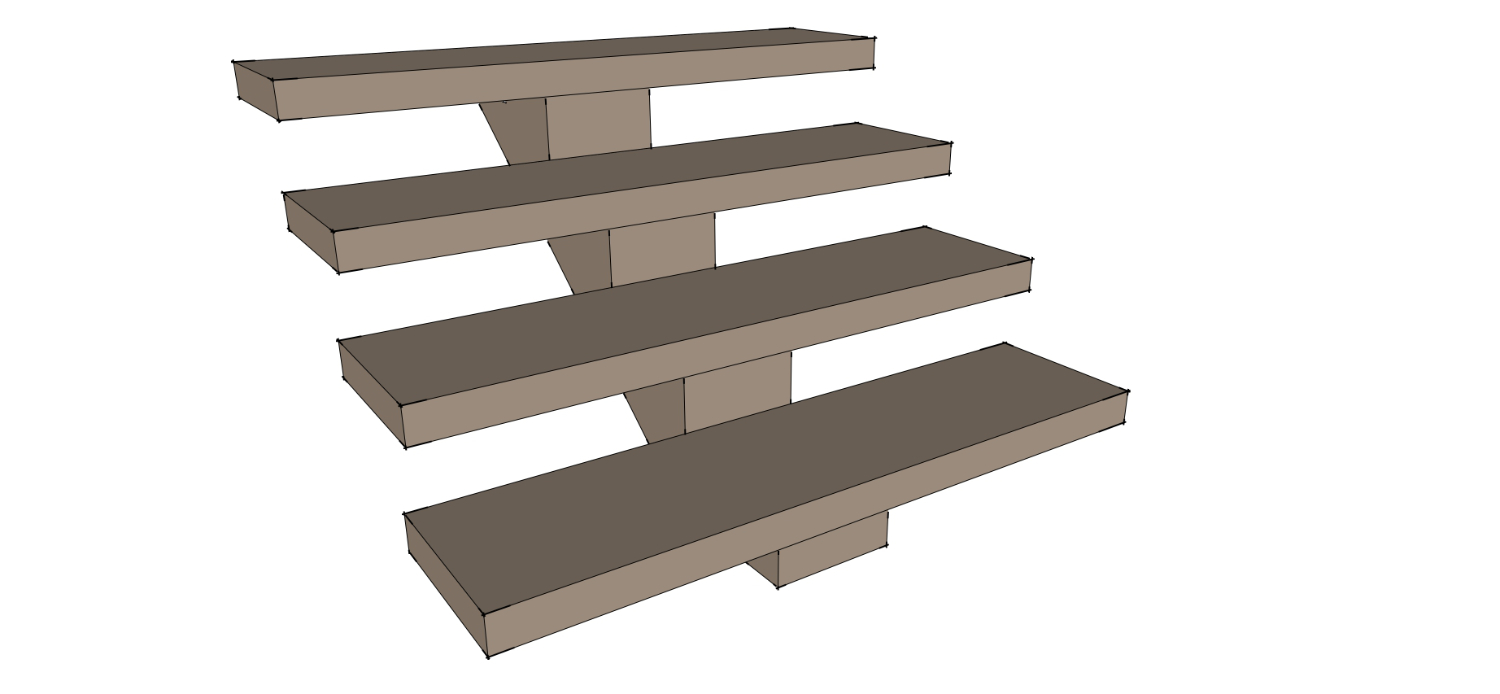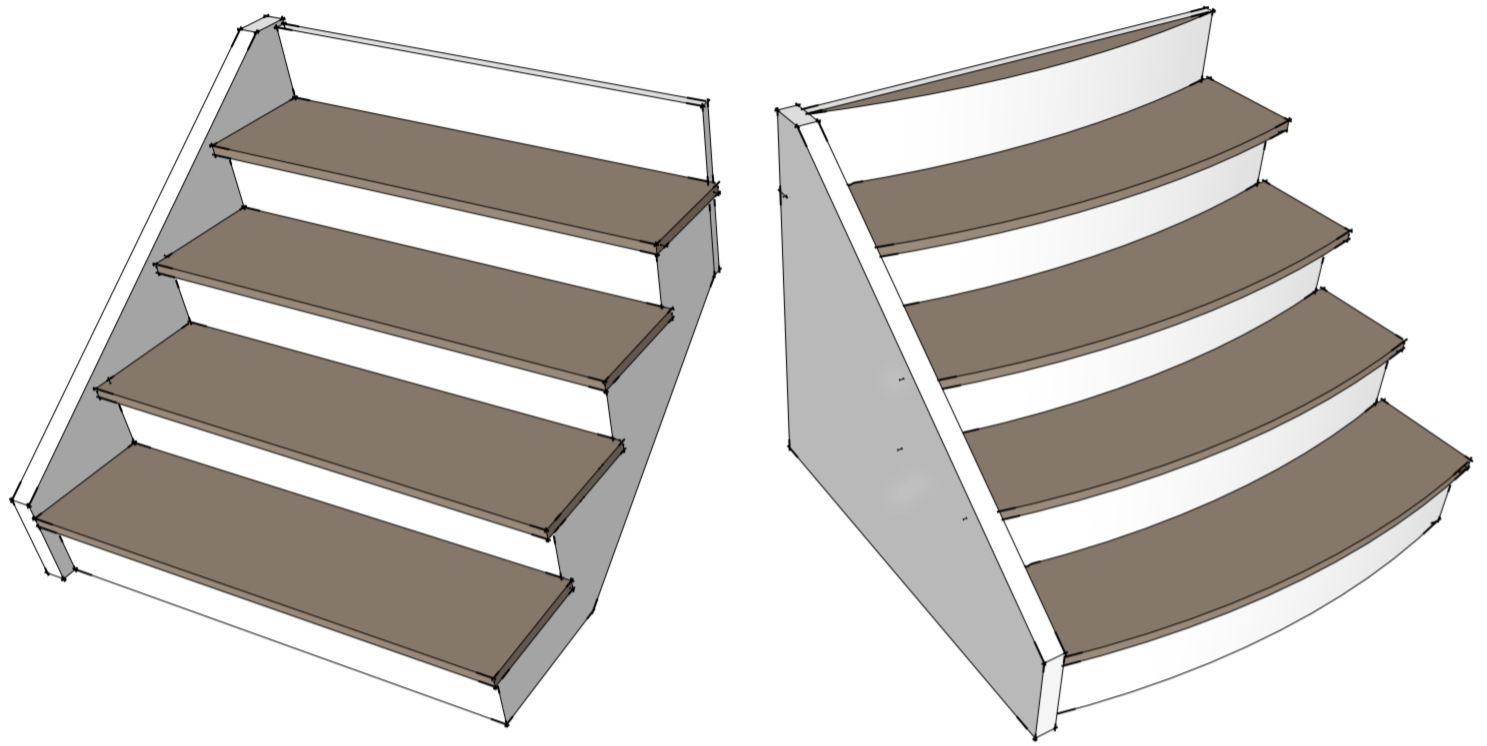Parts of a Staircase – A staircase has many components from the treads, fascia, stringers and more. Understand some of the terminology related to stairs, railings, and their components.
Understanding the Anatomy of a Staircase
The first thing to recognize is that there are two main components of staircases. This includes the tread and the riser. The tread is the flat part of the stair where you step.
We are explaining parts of a interior staircase. These are the correct terminology for the different parts of a staircase.
The riser is the vertical portion of the stair that connects two treads. As well as these two main components there are stringers, which are the sides of the stair that connects the tread and the riser of each stair together.
Stringers are referred to as the carriage in a staircase (when not referring to an individual stair).
The balustrade, which is made up of a collection of balusters (wood or metal vertical components between the stair and handrail) that holds up the handrail, the part we put our hands for security when ascending or descending the staircase, unless the stairs are enclosed.
You can also have a landing, which is a flat part of the stairs that connects two series of stairs together. This provides a safe place to stop before climbing again, or to turn around and switch directions.
The newel post is at the end of the balustrade and is a post that ends when the series of stairs end. There can be multiple, specifically if you have a landing.
You can Enlist Various Parts of Stair Case by reading this Super Lengthy Article on Various Components of Staircase and their Details.
Parts of Staircase by Name
This is the most comprehensive article on Various Components or Parts of Staircase and their Details on civil engineering blog. You can save or print names of different parts of a staircase. The Various Parts of a Staircase are as Follows –
- Baluster/Spindle
- Balustrade
- Curtail Step
- Flight
- Going
- Handrail
- Landing
- Line of Nosing
- Newel Post
- Nosing
- Railing
- Rise
- Riser
- Soffit
- Step
- String or Stringers
- Tread
- Winders
Definition of Staircase Parts
Staircases may be all sorts sizes and arrangements (with or without landings etc) to suit different properties but the main parts which go up to make any stair case are fairly common. A typical staircase is illustrated below with the main parts identified with more detailed definitions of each below.
Balustrade
What is Balustrade in Staircase? A balustrade is a collective name for the complete assembly of handrails, base-rails, newels, spindles, infill, and newer caps.
- Handrails
- Base-Rail
- Newels
- Spindles
- inFills
- Newer Cap
The combined framework of handrail and baluster is known as balustrade.
In Above Picture, Every Components from Blue color Part to another Blue color part is count as Balustrade.
Baluster
What is Baluster in Staircase? The vertical posts in the space under the banister to the treads or floor (on the side of a landing).
Baluster / Spindle is a vertical member or filling in between handrail and base rail. It is provided for safety and aesthetic purpose.
The vertical posts that hold up the handrail. Sometimes simply called guards or spindles. Treads often require two balusters. The second baluster is closer to the riser and is taller than the first.
The extra height in the second baluster is typically in the middle between decorative elements on the baluster. That way the bottom decorative elements are aligned with the tread and the top elements are aligned with the railing angle.
Banister
Banister The handrails up the side (or sides) of a stairway and, as an extension, along the edge of a landing.
The angled member for handholding, as distinguished from the vertical balusters which hold it up for stairs that are open on one side; there is often a railing on both sides, sometimes only on one side or not at all, on wide staircases there is sometimes also one in the middle, or even more.
Banister Meaning – The term “banister” is sometimes used to mean just the handrail, or sometimes the handrail and the balusters or sometimes just the balusters.
Bullnose
What is Bullnose in Staircase? Bullnose is known as Starting footstep. When stairs are unbolted on one or both sides, the initial step above the lower floor may be wilder than the other steps and rounded. A double bullnose refers to a staircase that is not against a wall and therefore there is a bullnose at both ends of the starting step.
Curtail step The bottom step of a staircase which curves around sideways beyond the side of the staircase. It is the starting step of the staircase, which projects out of the string. The curtail step can be constructed in a variety of designs.
Easing
What is Easing in Staircase? The word easing refers to any type of hand railing change in direction. Wall handrails are mounted directly onto the wall with wall brackets. At the bottom of the stairs, such railings flare to a horizontal railing and horizontal portion is called a starting rising.
At the top of the stairs, the horizontal portion of the railing is called – over easing.
Up easing is an element of a handrail that allows changing the direction of a handrail from angular to vertical.
Fascia The vertical covering under the edge of an exposed landing which covers the gap between ceiling and floor.
Flight
What is Flight in Staircase? A continuous series of steps without any break or landing is known as flight.
Fillet
What is Fillet in Staircase? The fillet is a decorative filler place on the floor between balusters on a balcony railing.
Finial
What is Finial in Staircase? A decorative ornament used to decorate the top (and possibly the bottom) of a newel post – often in the shape of an ball, spike, urn, bun, or figure.
A finial is a decorative cap to the top of a newel post, particularly at the end of the balustrade.
Flutes
What is Flutes in Staircase? Flutes are decorative vertical grooves sometimes routed into the wood surface of the spindle of newel posts.
Gooseneck
What is Gooseneck in Staircase? A gooseneck is a vertical handrail that joins a sloped handrail to a higher handrail on the balcony or landing. It is the part of the stair hand railing.
Gooseneck= Vertical turn + Up-ramp.
Goosenecks come in a variety of shapes and sizes. Don’t purchase a gooseneck that doesn’t match with your handrail.
Going
What is Going in Staircase? Going is the width of the tread between two successive risers. In other words, it is horizontal distance between the faces of any two consecutive risers.
Handrail
What is Handrail in Staircase? The term “Handrail” is sometimes used to mean just the banister or sometimes just the balusters. A handrail is a rail that is designed to be grasped by the hand to provide stability or support. It is also known as railing or banister. They are typically supported by posts or mounted directly to walls.
There is often a railing on both sides, sometimes only on one side or not at all, on a wide staircase, there is sometimes also one in the middle or even more. The handrails up the side or sides of a stairway and, as an extension, along with the edge of a landing.
This is a protective bar placed at a convenient distance above the stairs for support. Elderly people can rest their hands on handrail to climb stairs easily.
The whole staircase is the assembly of all the aforementioned parts. The various parts of a staircase can vary according to the type and material of the staircase.
Railing is a framework of enclosure supporting a handrail and serves as a safety barrier.
Half Landing The flat area of flooring where a stairway makes a turn between main floors.
Inner (closed) string The side of a staircase set against a wall which locates the treads and risers.
Landing The flat area of flooring at the top and bottom of a staircase leading to rooms. Landing is a platform provided between two flights.
A landing extending to full width of staircase is known as half spaced landing and the landing extending to only half across a staircase is called as quarter space landing.
Newel
What is Newel in Staircase? The newel is a sturdy vertical post at the end or turn of a banister. Newel is also known as a central pole or support column. Since it is a structural component, it extends below the floor and subfloor to the bottom of the floor joists and is bolted right to the floor joist. There are four kinds of newel stair posts which are- standard, landing, pin-top, and stabilizer newel posts. Visually it looks like half the newel is embedded in the wall. For open landings, a newel may be extended below the landing for a decorative newel drop.
Newel post The vertical post at the end or turn of a banister. Newel post is a vertical post placed at the top and bottom ends of flights supporting the handrails.
Nosing
What is Nosing in Staircase? Nosing is the horizontal, protruding edge of a stair where most foot traffic occurs. Mostly, it is the half rounded molding fixed to the ends of the threads exposed in a half which covers where the balusters fit into the treads. Nosing is the edge of the tread projecting beyond the face of the riser and the face of a cut string. This is where the thread above a riser overhangs it.
Outer (open) string The side of a staircase open to view which locates the treads and risers.
Return nosing – The molding, (normally half round) fixed to the ends of the treads exposed in a hallway and which covers where the balusters fit into the treads.
Line of Nosing – An imaginary line touching the nosing of each treads parallel to the slope of the stair is known as line of nosing.
Rise
Rise is a vertical distance between the upper faces of any two consecutive steps.
Riser
What is Riser in Staircase? Riser The vertical part of a step. Riser is a vertical member between two treads. Riser provides a support to the treads.
or
The riser is the vertical surface of the stair. The tread on the other hand is the horizontal surface of the stair and the part of the stair you step on.
The riser is the vertical portion between each tread on the stair. Not all stairs have risers. The rise-less steps are known as the open thread. Open riser stairs have grown in popularity in recent years. Closed tread stair has risers included. The vertical board forms the face of the step, also forms the space between one step and the next.
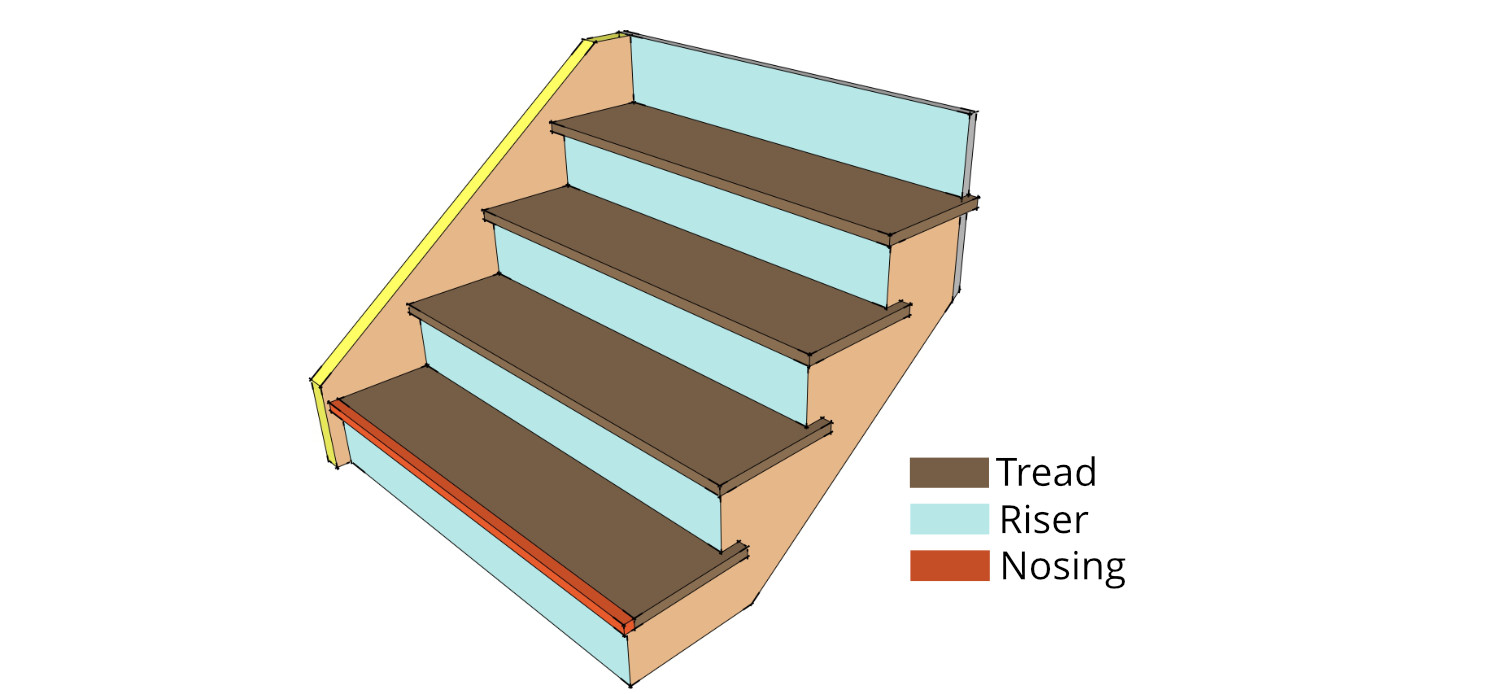
Material used for Stair Riser
It is a vertical component where the material can be timber, steel, glass, acrylic, panel production tiling.
Shape and Size of Stair Riser
Stair riser heights shall be 7 inches (178mm) maximum and 4 inches (102mm) minimum. The height shall be measured vertically between the nosings of adjacent treads. The greatest riser height within any flight of stairs shall not exceed the smallest by more than 3/8 and the rise shall not be less than 11 inches. Check the local building codes on stair riser height if you are building your own staircase.
Usage of Stair Riser
- Risers adjacent to a public way
- Used in the walkways or a driveway serving.
Rise is a vertical distance between the upper faces of any two consecutive steps.
Riser wedges
Riser wedges The, usually wooden, wedges used vertically underneath a staircase in slots cut into the strings to secure the risers.
Rosette
What is Rosette in Staircase? Where the handrail terminates in the wall and a half-newel is not used, it may be trimmed by a rosette. It is an optional decorative wood stair part. While they are more of an ornamental feature, the process of attaching a handrail to a wall is made easier through using them. If your balustrade is a traditional style, then rosettes will add an additional piece of elegant detail. However, if you prefer a cleaner more contemporary, you should probably consider not adding rosette.
Soffit
Soffit is the underside of a stair.
Spindles
Spindles, which are vertical wood or metal structures, are interspersed between posts to provide a safety barrier along the stair system.
Step
What is Step in Staircase? A step is composed of tread and riser.
String
What is stringer or stringer board in Staircase? There are the structural supports that run along either side of the staircase, though the treads may be supported in many other ways. The stringers are sometimes notched so that the risers and treads fit into them.
String is a sloping member which supports the steps in a stair.
Western Stringers
Also called closed, routered or housed stringers.
From the side view a western stringer is a consistent ribbon with the treads and risers routered into the inside face of the stringer.
Eastern Stringers
Also called sawtooth or open stringers.
From the side view an eastern stringer is cut out on the rise and run.
Mono Stringers
A mono stringer stair uses a single ‘beam–like’ stringer that supports the centre of the treads
from below and no risers are present.
Tread
Tread The horizontal part of a step. The part of the stairway that is stepped on. It is constructed to the same specifications (thickness) as any other flooring. The tread “depth” is measured from the outer edge of the step to the vertical “riser” between steps. The “width” is measured from one side to the other.
Tread is a scrap of the stairway that is stepped in. It is the top or horizontal surface to press beneath the feet. It is trodden on while climbing or descending the staircase. It is constructed to the same thickness as another flooring.
There is always one fewer tread than risers in a staircase. The overall horizontal distance of the stairs will be the number of threads added together.
- Straight Tread: A straight tread is a stair where the nosing is straight and no increased front edge curve is present.
- Convex Tread: A convex tread has a curved front edge between two stringers.
Tread wedges The, usually wooden, wedges used horizontal underneath a staircase in slots cut into the strings to secure the treads.
Tread/riser blocks The, usually wooden, blocks used by gluing to secure the front of the treads to the top of the risers at the front edge of each step.
Trim
What is Trim in Staircase? Trim is usually applied where walls are supposed to meet the ground and i often used where the tread and riser meet. Shoe molding may be used between where the lower floor and the first riser meet. Trimming a starting step is a special challenge as the last riser above the lower floor is rounded.
Trim (e.g. quarter-round or baseboard trim) is normally applied where walls meet floors and often underneath treads to hide the reveal where the tread and riser meet.
Shoe moulding may be used between where the lower floor and the first riser meet. Trimming a starting step is a special challenge as the last riser above the lower floor is rounded.
Flexible, plastic trim is available for this purpose, however wooden mouldings are still used and are either cut from a single piece of rounded wood, or bent with laminations Scotia is concave moulding that is underneath the nosing between the riser and the tread above it.
Turnout
What is Turnout in Staircase? Instead of a complete spiral volute, a turnout is a quarter turn rounded end to the handrail. It is a stylish way to start a stairway. They are less dramatic than volutes but still attractive.
Turnout is of two types- left and right-hand turnout.
If you are facing the bottom of the stairway, a right turnout would be on the right side of the stairway and a left turnout would be on the left side.
A turnout must have a pin top newel post below.
Volute
What is Volute in Staircase? A volute is a handrail end component for the curtail or bullnose footsteps that curve inward like a spiral. It is said to be left or right-handed depending on which side of the handrail is as one faces up the stairs. The detail is like a scroll at the entry of a handrail, sometimes called a monkey’s tail.
Available with an up-ramp, it is installed at the bottom of the side on a starting step, extending out from the side of the staircase. However, it has the most difficult installation process you can find in a staircase.
Winders
What is Winder in Staircase? Winders are the steps that are narrower on one side than the other. A series of winders form a circular or spiral stairway.
Winders are the tapering steps used for changing the direction of the stair.
Stairway winders or turns involve triangular treads to complete the turn. When three steps are used to turn a 90-degree corner, the middle step is called a kite winder as a kite double winder.
As per the Toronto Home inspection, it shows that only one set of winders should be allowed in a staircase and the dimensions should be tripping hazards.
Although it may seem hard, remembering staircase parts are very simple. Knowing the different parts and their names and functions will give you a better understanding of what they are, especially when you speak to a builder, architect, or any other construction industry professional regarding the topic when you are making your design project choices.
